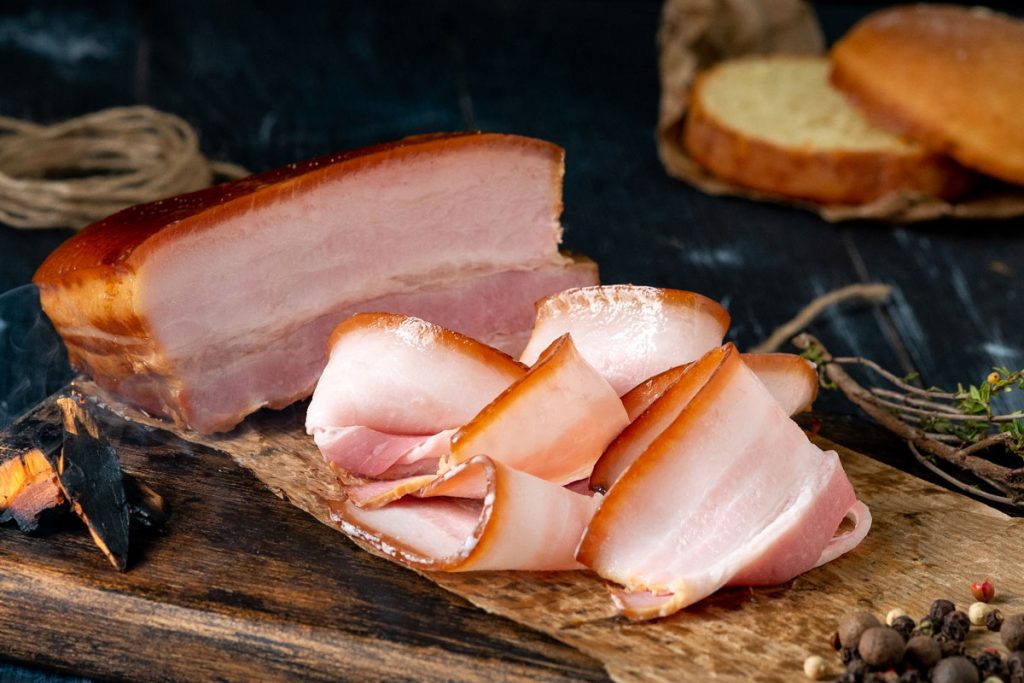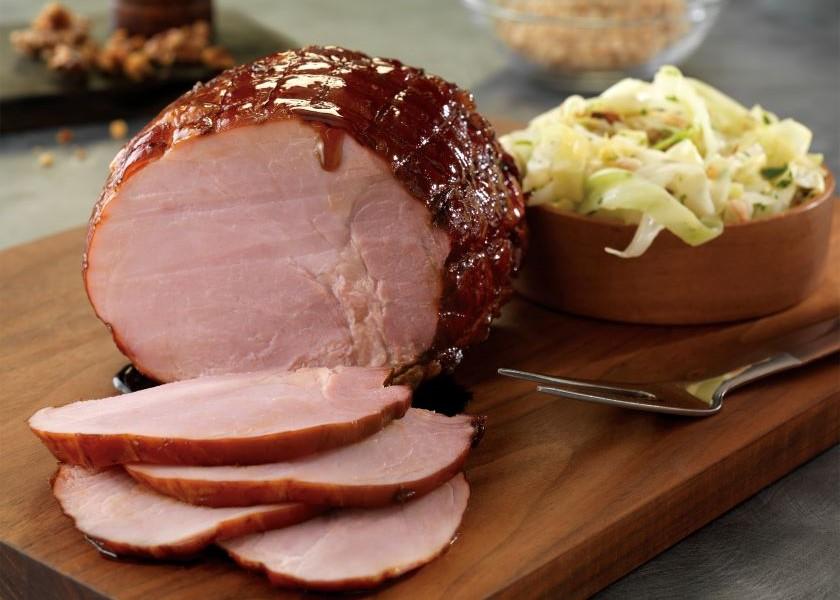Introduction

Uncured ham, a newer addition to the market, has gained popularity as a healthier alternative to cured ham. While it may sound like uncured ham is completely free of curing agents, it actually utilizes natural ingredients like celery juice or sea salt, which contain naturally occurring nitrates. In contrast, cured ham, the more traditional and widely available type, is cured using chemical additives. In this article, we will dive into the world of uncured ham, exploring its different curing methods, the variety of products available, and the health implications associated with consuming it. So, let’s uncover the secrets of uncured ham and discover its culinary significance.
Background On Uncured Ham And Its Popularity
Uncured ham has gained popularity in recent years as a healthier alternative to cured ham. With a growing focus on clean eating and natural ingredients, consumers are seeking out products that are free from chemical additives. Uncured ham has been touted for its use of natural curing agents like celery juice or sea salt, which contain naturally occurring nitrates. This has resonated with health-conscious individuals who are looking for options that are lower in sodium and free from artificial ingredients. The increasing demand for uncured ham is a reflection of the shifting consumer preferences towards more natural and wholesome foods.
What Makes Uncured Ham Different From Cured Ham
Uncured ham is different from cured ham in terms of the curing method used. Cured ham is typically made using synthetic nitrates, which can be converted into harmful chemicals. On the other hand, uncured ham goes through a more natural curing process. It is often cured using natural ingredients like celery juice or sea salt, which contain naturally occurring nitrates. These natural curing agents are considered to be healthier alternatives to synthetic nitrates. Uncured ham is also known for its lower sodium content and absence of artificial additives, making it a popular choice for those seeking a more natural and wholesome option.
Traditional Curing Methods

Traditional curing methods have been used for centuries to preserve and enhance the flavor of ham. One such method is salt-curing, where the uncured ham is coated in a mixture of salt and other seasonings. The salt draws out moisture, inhibiting bacterial growth and extending the shelf life of the meat. This process also helps to develop a rich and savory flavor. Another traditional method is air-drying, where the uncured ham is hung in a controlled environment to slowly age and dry. This method enhances the flavors and creates a unique, intense taste profile. Both of these methods have stood the test of time and continue to be appreciated for their ability to produce delicious cured ham.
Salt-curing Uncured Ham And Its Benefits
Salt-curing is one of the traditional methods used to cure uncured ham. By coating the ham in a mixture of salt and seasonings, the salt draws out moisture, inhibiting bacterial growth and extending the shelf life of the meat. This process not only preserves the ham but also enhances its flavor. The salt-curing method creates a rich and savory taste profile that is loved by many. Additionally, salt-cured uncured ham has a firm texture and a deep, intense flavor that adds a delicious dimension to various dishes.
Air-drying Uncured Ham And Its Flavor Profile
Air-drying is another traditional method used to cure uncured ham. It involves hanging the ham in a controlled environment to allow it to dry naturally over time. This process intensifies the flavors of the ham and creates a unique and complex taste profile. The air-drying method enhances the natural sweetness of the pork while developing a rich, nutty flavor. The result is a ham with a firm texture and a distinct, savory taste that is often enjoyed thinly sliced as a delicacy. Air-dried uncured ham offers a sophisticated culinary experience with its nuanced flavors and delightful texture.
Modern Curing Methods

Modern curing methods have introduced innovative ways to cure uncured ham. One modern technique involves natural curing using celery juice powder. This powder is rich in natural nitrates, which act as a curing agent. It is mixed with other spices and rubbed onto the ham, allowing it to cure slowly over time. Another modern method is brine-curing, where the ham is immersed in a brine solution that contains salt, sugar, and other flavorings. This method ensures even distribution of flavors and results in a moist and tender ham. Modern curing methods offer convenience and consistency while preserving the delicious flavor of uncured ham.
Natural Curing Of Uncured Ham Using Celery Juice Powder
In modern curing methods, one innovative technique involves natural curing of uncured ham using celery juice powder. This powder, rich in natural nitrates, acts as a curing agent. The celery juice powder is combined with other spices and rubbed onto the ham, allowing it to cure slowly over time. This method offers a more natural and healthier alternative to traditional curing methods. Celery juice powder brings out the delicious flavor of uncured ham while preserving its quality and texture. Plus, it provides peace of mind for those looking to avoid synthetic nitrates in their food.
Brine-curing Uncured Ham And Its Advantages
Brine-curing is another popular method used to cure uncured ham. In this process, the ham is soaked in a solution of water, salt, and sometimes sugar or other seasonings. Brine-curing offers several advantages when it comes to preserving and flavoring the ham.
Advantages of brine-curing uncured ham include:
- Enhanced flavor: The brine solution infuses the ham with a delicious combination of flavors, resulting in a more pronounced and satisfying taste.
- Moisture retention: The brine helps the ham retain moisture, ensuring a tender and juicy texture when cooked.
- Longer shelf life: Brine-cured hams have a longer shelf life compared to uncured ones, thanks to the preservation properties of the salt in the brine.
- Versatility: Brine-cured ham can be used in a variety of recipes, from sandwiches and salads to main dishes and appetizers.
Overall, brine-curing is a popular method for enhancing the flavor and shelf life of uncured ham, making it a versatile and delicious choice for any meal.
Uncured Ham Products In The Market

Uncured ham products have become increasingly popular in the market due to the rising demand for healthier and more natural food options. There are various varieties of uncured ham available, including nitrate-free, organic, and pasture-raised options. These products often boast labels highlighting their natural ingredients and hormone-free status. Uncured ham is also available in different forms, such as sliced deli ham, ham steaks, and whole hams. Consumers can easily find uncured ham products in grocery stores, specialty meat markets, and online retailers. With the wide range of options available, individuals can choose the uncured ham product that best suits their preferences and dietary needs.
Varieties Of Uncured Ham Available
There are various varieties of uncured ham available in the market to cater to different tastes and dietary preferences. Some common options include nitrate-free uncured ham, organic uncured ham, and pasture-raised uncured ham. Nitrate-free uncured ham is popular among those who want to avoid preservatives, while organic uncured ham appeals to those who prefer products made with organic ingredients. For those concerned about animal welfare, pasture-raised uncured ham is a great choice. Consumers can easily find these varieties of uncured ham at grocery stores, specialty meat markets, and online retailers.
Comparing The Taste And Texture Of Different Uncured Ham Products
When it comes to uncured ham, there is a wide variety of options available, each offering its own unique taste and texture. Nitrate-free uncured ham tends to have a milder flavor compared to traditionally cured ham. Organic uncured ham, made with organic ingredients, may have a slightly more earthy and natural taste. Pasture-raised uncured ham, known for its superior quality and rich flavor, can provide a more robust and succulent experience. Ultimately, the taste and texture of uncured ham products can vary, allowing individuals to choose the option that best suits their preferences. Whether you prefer a delicate flavor or a bold, hearty taste, there is an uncured ham product for everyone.
Health Implications And Considerations

When it comes to health implications, there are important factors to consider when consuming uncured ham. Unlike cured ham, which often contains nitrates that can be harmful to human health, uncured ham is preserved using natural ingredients and methods such as salt, black pepper, celery powder, and spices. This makes uncured ham a healthier alternative for those concerned about the potential risks associated with consuming nitrates. However, it is still important to consume uncured ham in moderation as part of a balanced diet, as excessive consumption of any processed meat can have negative health effects.
Exploring The Health Benefits Of Uncured Ham
Uncured ham offers several health benefits compared to its cured counterpart. Unlike cured ham, which often contains synthetic nitrates that can be converted into harmful chemicals, uncured ham is preserved using natural ingredients like salt, black pepper, celery powder, and spices. This natural curing process eliminates the potential health risks associated with consuming nitrates. Additionally, uncured ham is typically lower in sodium and has fewer artificial additives. It also retains more of its natural flavors and textures, providing a healthier and tastier option for ham lovers.
Understanding The Potential Risks Associated With Consuming Uncured Ham
While uncured ham offers numerous health benefits, it is essential to understand the potential risks as well. Uncured ham is not subject to the same preservation methods as cured ham, which means it has a shorter shelf life. Without the use of synthetic nitrates, uncured ham may be more susceptible to spoilage and bacterial growth if not handled and stored properly. It is crucial to follow proper food safety guidelines, including refrigeration and cooking to the appropriate temperature, to minimize the risk of foodborne illness.
Conclusion

In conclusion, uncured ham provides a delicious alternative to traditional cured ham, offering a more natural and health-conscious option. With its unique curing methods using natural nitrites and absence of synthetic nitrates, uncured ham appeals to those seeking a minimally processed meat choice. However, it is important to be aware of potential risks associated with spoilage and bacterial growth if uncured ham is not handled and stored properly. By following proper food safety guidelines, individuals can enjoy the flavors and benefits of uncured ham while minimizing the risk of foodborne illness.
Final Thoughts On Uncured Ham And Its Culinary Significance
Uncured ham offers a flavorful and health-conscious alternative to traditional cured ham. With its natural curing methods and absence of synthetic nitrates, uncured ham appeals to those seeking minimally processed meats. Its unique flavor profile and versatility make it a popular choice in various recipes, from sandwiches to main dishes. However, it is essential to handle and store uncured ham properly to prevent spoilage and bacterial growth. By following food safety guidelines, individuals can enjoy the delicious taste and benefits of uncured ham while minimizing risks. Incorporating uncured ham into your culinary repertoire can add a wholesome and delectable touch to your meals.
Tips For Enjoying Uncured Ham In Various Recipes
- Incorporate uncured ham into sandwiches for a delicious and nutritious meal. Pair it with fresh vegetables and whole grain bread for a balanced option.
- Add diced uncured ham to omelettes or frittatas for a protein-packed breakfast.
- Use sliced uncured ham as a topping for homemade pizzas or as a flavorful addition to pasta dishes.
- Enhance the flavor of soups, stews, and casseroles by adding chunks of uncured ham.
- Create a satisfying charcuterie board by pairing thinly sliced uncured ham with your favorite cheeses, fruits, and crackers.
- Experiment with different seasonings and spices to elevate the taste of uncured ham in your recipes. Enjoy the versatility and natural flavors of uncured ham in a variety of dishes.
Frequently Asked Questions About Uncured Ham
Q: What is uncured ham?
Uncured ham refers to a variety of ham that has not been treated with traditional curing agents like nitrates or nitrites. Instead, it is typically preserved and flavored using natural methods such as sea salt, sugar, and spices.
Q: How does uncured ham differ from cured ham?
The key difference between uncured and cured ham lies in the way they are preserved. Cured ham is treated with curing agents, such as nitrates or nitrites, which help preserve the meat, add flavor, and give it the characteristic pink color. On the other hand, uncured ham does not contain these curing agents and relies on alternative preservation methods.
Q: Is uncured ham healthier than cured ham?
Many people consider uncured ham to be a healthier alternative to cured ham. This is primarily because uncured ham does not contain nitrates or nitrites, which can potentially form nitrosamines, compounds that have been linked to certain health risks. However, it’s important to note that uncured ham can still be high in sodium and fat, just like its cured counterpart.
Q: How does uncured ham taste?
The taste of uncured ham can vary depending on the specific seasonings and spices used during the curing process. However, it is generally described as having a more natural and subtle flavor compared to cured ham, which can be noticeably salty and savory. Uncured ham may also have a slightly different texture due to the absence of curing agents.
Q: Can I cook uncured ham in the same way as cured ham?
Yes! Uncured ham can be cooked in the same way as cured ham. You can bake, roast, grill, or boil it, depending on your preference and the recipe you are following. It’s important to note that since uncured ham does not have the same preservatives, it might have a shorter shelf life than cured ham, so it’s a good idea to check the expiration date and safely store any leftovers.
Q: Where can I buy uncured ham?
Uncured ham is widely available in many grocery stores, specialty food markets, and even online retailers. You can find it in the fresh meat or deli section of the store, and it is often labeled as “uncured” or “nitrate/nitrite-free” ham. If you are unsure, it’s always helpful to ask a store representative for assistance.
Q: Can I substitute uncured ham for cured ham in recipes?
Yes, you can typically substitute uncured ham for cured ham in most recipes without major adjustments. However, it’s important to keep in mind that the flavor and saltiness might differ slightly. It’s recommended to adjust the seasoning accordingly if necessary. As always, feel free to experiment with recipes and adapt them to your taste preferences.
Q: Are there any other alternatives to uncured ham?
Yes, if you’re looking for alternatives to traditional cured ham, there are various options available. Some popular alternatives include smoked turkey, tofu bacon, or even vegetarian or vegan-friendly hams made from plant-based proteins like seitan or tempeh. These alternatives offer different flavors and textures, ensuring that you can enjoy a delicious ham-like experience, regardless of dietary preferences or restrictions.
Remember, whether you choose uncured ham or cured ham, the most important thing is to enjoy your meal in moderation and savor the flavors that suit your taste buds and dietary needs.

Halal Meat Bazar is a leading provider of HMC-approved quality halal meat, offering competitive prices and exceptional services. With a commitment to excellence, we cater to both wholesale and retail customers, ensuring that everyone has access to premium halal meat products. Our journey began with a passion for providing the finest quality halal meat to the community. Founded on the principles of integrity and quality, Halal Meat Bazar has consistently upheld the highest standards in sourcing, processing, and delivering halal meat products. Our dedication to maintaining the authenticity of halal meat has earned us the trust and loyalty of our customers.